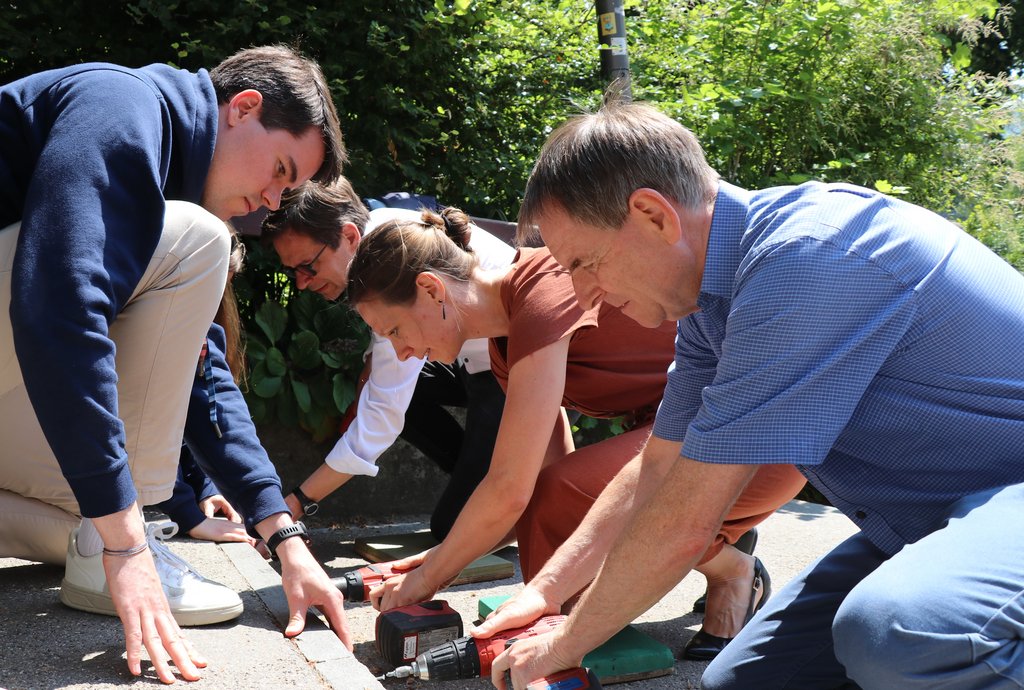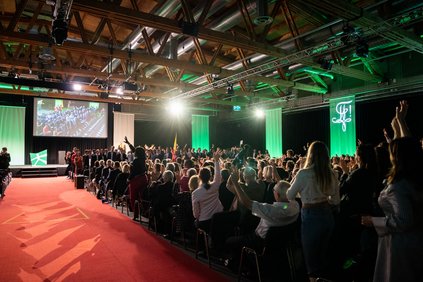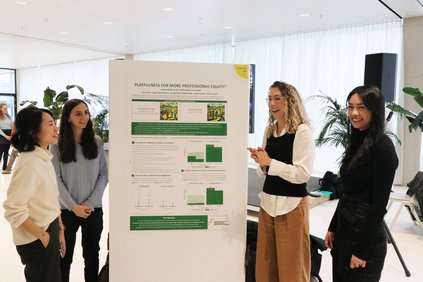Campus - 08.06.2023 - 14:57
HSG students raise awareness of climate change with "climate staircase"
HSG students have transformed a staircase leading up from St.Gallen city centre to the university into a climate diagram: Each step represents a year and shows with colours how temperatures are rising in Switzerland as well. This "climate staircase" is intended to raise awareness of climate change. The city of St.Gallen supports the project together with the HSG.

Those who want to walk from St.Gallen city centre to the HSG often take the most direct route through Dohlengässlein: the staircase with 162 steps is used daily by many city residents and university staff. Now, students of the Master's Certificate "Managing Climate Solutions" have marked the steps of the Dohlengässlein in different shades of red and blue. Each step of this "climate staircase" stands for a year and shows to what extent the average temperature in Switzerland has deviated downwards (blue shades) or upwards (red shades).
The further up you climb towards the year 2023, the more the red to dark red bars accumulate. The steps representing the years 2023 to 2030 are left white and encourage reflection on one's own climate actions with questions and prompts.
City of St.Gallen participates in the project
On 8 June 2023, HSG members and St.Gallen City Councillor Peter Jans ceremoniously inaugurated the staircase. "With the climate staircase, we would like to draw the attention of the population of the city of St.Gallen and especially the students of the University of St.Gallen to the local effects of global warming," said Master's student Noémie Schaub at the foot of the staircase. Switzerland, she said, is twice as affected by climate change as the rest of the world, with a warming of two degrees Celsius.
Peter Jans, who heads the city's Technical Operations Directorate, said: "In order to take action against climate change, we also need an awareness that we can all influence this development with our behaviour." The climate staircase makes a contribution to this, which is why the city has supported the project financially together with the HSG.
Employees of the city's civil engineering office installed the coloured strips together with the four HSG students Noémie Schaub, Anna-Lena Heinzen, Massimo Wenk and Mikal Orgland. They implemented the climate stairs project as part of the Managing Climate Solutions (MaCS) certificate.
In the MaCS, launched in 2020, HSG Master's students develop entrepreneurial approaches for the fight against climate change. In the process, they implement various practical projects. Several employees of the municipal administration also helped with the planning and implementation of the "climate staircase". At its opening, Peter Jans, together with MaCS programme leaders Rolf Wüstenhagen and Merla Kubli, applied the last coloured strips.
Information complements the climate graphic
Information complements the climate graphic
In addition to the coloured visualisation, several QR codes are attached to the banisters. They provide in-depth information on climate change, its effects, political milestones and measures as well as ideas for climate protection in everyday life.
Climate protection is a component of the HSG's strategy. The HSG Rectorate has signed the "Global Climate Letter for Universities and Colleges" and is part of the UNFCCC campaign "Race to Zero". Within this framework, the HSG has set itself the goal of becoming CO2-neutral by 2030. With its Energy Concept 2050, the City of St.Gallen is also committed to a policy that focuses on energy efficiency, the careful use of energy and renewable energy. On the basis of the article Climate Protection and Climate Change in the Municipal Code, which was approved by the St.Gallen electorate, the city is pursuing the goal of climate neutrality by 2050.
More articles from the same category
This could also be of interest to you
Discover our special topics
















